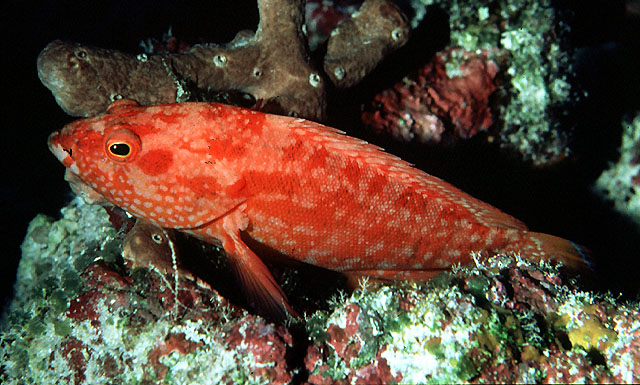| Epinephelidae (Groupers) |
| 30 cm TL (male/unsexed) |
|
reef-associated; marine; depth range 0 - 110 m, non-migratory |
| Indo-Pacific: Pinda, Mozambique (15°S) to French Polynesia and the Pitcairn Group, north to the Ryukyu Islands, south to Heron Island at the southern end of the Great Barrier Reef. Often misidentified as Cephalopholis aurantia (or as Cephalopholis analis, a junior synonym of Cephalopholis aurantia). |
|
Dorsal spines (total): 9-9; Dorsal soft rays (total): 14-16; Anal spines: 3-3; Anal soft rays: 9-10. Characterized by pinkish red to pale reddish orange color; mottling of darker red to brownish red; median fins with narrow blue marginal stripe; body scales ctenoid, cycloid scales ventroanteriorly on abdomen; greatest depth of body 2.7-3.2 in SL; rounded caudal fin; pelvic fins 1.9-2.2 in head length (Ref. 90102); eyes large, diameter about twice the depth of the preorbital; interorbital area flat; rounded preopercle, very finely serrate, shallow notch, fleshy lower edge; smooth or with serrae subopercle and interopercle; scaly maxilla, reaching to or well beyond vertical at rear edge of eye (Ref. 089707). |
| Perhaps the most common grouper on Indo-Pacific coral reefs found below 40 m. The species is only known from insular localities except those collected from Pinda, Mozambique. Feeds on crabs and other crustaceans (Ref. 89972). The small size (<22 cm TL) and deep-water habitat of this species makes it less vulnerable to fishing (Ref. 58472). Solitary (Ref 90102). |
|
Least Concern (LC); Date assessed: 20 March 2017 Ref. (130435)
|
| harmless |
Source and more info: www.fishbase.org. For personal, classroom, and other internal use only. Not for publication.

